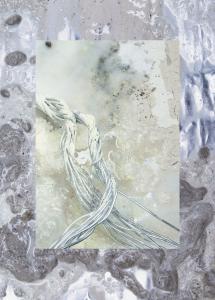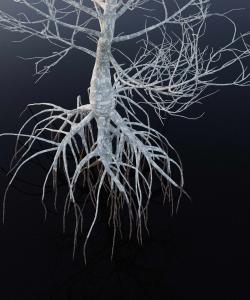Artist Urte Janus presents a sculpture installation that will change by reacting to humidity, temperature, and light. Curated by Olivia Grace Middelboe.
LONDON, UK, UNITED KINGDOM, May 13, 2023/EINPresswire.com/ — The Anglican Chapel
Nunhead Cemetery
Linden Grove, London, SE15 3LP
8th – 30th June
Private View – 8th June, 15:30pm – 18:30pm
Please RSVP via this link – https://55ma.rsvpify.com
Curated by Olivia Grace Middelboe.
Urte Janus presents “55 MA,” a new installation in response to The Anglican Chapel in Nunhead Cemetery, one of the Magnificent Seven cemeteries in London. Janus’ sculptures will change over the duration of the exhibition by reacting to humidity, temperature, and light. “55 MA” refers to 55 million years ago when the primary sediment holding the cemetery and the chapel – London clay – was deposited at the bottom of a warm tropical sea covering the whole city. Janus invites visitors to travel in time and experience the different time scales that the chapel holds. In her artistic expression, Urte sees the landscape of the Nunhead Cemetery as not only a resting place for many but also a memorial for an ancient ecosystem that paved the way for our existence.
“In my mind, I try to imagine what lies below my feet. I try to feel the time locked in the soil, clay and rock sediments. In my mind, I am excavating the earth below the Chapel. Below the building, under a layer of humus, London Clay lays 132m thick, holding the city of London. It is incredibly easy to tunnel through and was instrumental in building the underground systems and many London buildings.
But it also indicates different geological times. At its formation, this place was at the bottom of an acidic tropical sea. The clay still holds the turtles, sharks and unsprouted ancient seeds. Their bodies still have chemical memories of the ancient landscapes.
It makes me think this cemetery is also a resting ground for an extinct ecosystem.
I imagine mangroves growing from the stone floors and ancient seeds sprouting again. By resurrecting elements of this lost world, I want to reflect on the timescales deeper than ours. This site has an ever-unfolding history of its own.
However, my mangroves are made from modern materials – man-altered substances that will eventually create new geological layers. I measure the time by how slowly and quickly things crumble – concrete – 50 years, aluminium – 200 years, forever chemicals – 1000 years, glass – 1 million years.
The sculptures also connect to the present moment and place – they react to immediate temperature and light changes by shifting their colours as the days pass. They may also slowly collapse when exposed to elements.
I imagine the future sediments that will cover the Chapel. What traces of our civilisation will be held within?”
– Urte Janus
Urte Janus is an artist from Lithuania currently living in London, where she is doing a studio residency at Sarabande Foundation. After initially gaining a degree in photography, she taught herself sculpture and video making. Material exploration plays a vital role in Janus’ practice. She uses chemistry to develop her pieces and likes to initiate slow reactions, especially with acid. Janus blends raw elements such as gelatine, charcoal, ash, limestone, salvaged metals and natural binders to build pieces that can later disintegrate back into their surroundings. Her sculptures usually live lives of their own – they change and develop over time.
In her installations, forms of ancient extinct animals and plants, human structures, minerals, man-made chemicals and organic substances collapse into one. Rather than thinking of storylines, Janus thinks of timelines, measuring time by how slow or fast the elements of her pieces grow, change, vanish or extend into the future. Spanning from the deep past to the far future, she explores the entangled lives and possibilities of organic and non-organic ever-changing matter.
Further information about Nunhead Cemetery can be found at www.fonc.org.uk
Urte Janus
Urte Janus
+44 7956 219365
email us here
![]()
Originally published at https://www.einpresswire.com/article/632170392/urte-janus-unveils-55-ma-a-captivating-chemically-active-sculpture-installation-at-nunhead-cemetery-s-anglican-chapel






